For years, Chinese growth rates have been a byword for extremely fast economic development, and the phrase is still used that way. Unfortunately for China, the country doesn’t actually have “Chinese growth rates” anymore.
China grew 7.4% last year, missing its own 7.5% target and notching its slowest expansion since 1990. Some analysts think even that is a massive overestimation, Business Insider reported.
This is unlikely to be a temporary setback—the slowdown is the new normal for the world’s second-biggest economy. Within the next decade, China is very likely to be recording growth rates less than half of what it did in the 1980s, 1990s, and 2000s.
That may not seem like such a bad thing. After all, the growth rates that are projected for China are still stronger than pretty much any western country is expecting for itself. But there are some compelling reasons for both China and the rest of the world to worry about a Chinese slowdown.
$6.9t in Wasted Investments
China has headed up the emerging-market credit splurge since the 2008 financial crisis. While the recessions in advanced economies threw some cold water over borrowing in the developed world, emerging markets have been racking up debt at quite a speed, with China first among them.
The combination of low inflation and lower growth is a poisonous cocktail as far as paying off debt is concerned. If you borrow on the presumption of, say, 5% inflation and 10% growth in gross domestic product, you have a lot of wiggle room—within five years, your economy (and hopefully your business) will be a lot larger, making your debts look proportionally small.
It’s worthwhile for developing countries to use public debt when they are industrializing rapidly, but that doesn’t mean those bets can’t turn sour if the economy doesn’t develop as rapidly as anticipated. Chunks of that debt went to poor investments made by profligate local governments: Chinese research indicates as much as $6.9 trillion was invested wastefully from 2009 to 2014.
The Middle-Income Trap
A pessimistic take suggests China may be drifting into a scenario that has haunted countries around the world during the past 50 years: a middle-income trap.
A joint IMF-Chinese report published in 2013 notes that very few countries actually escape the middle-income trap. For many countries, making the transition between genuinely impoverished and middle-income seems relatively easy in comparison with catching up to the rich world. Most of those that have made it out have, like China, been located in East Asia.
In 2011, an IMF report named China as the biggest source of real economic spillovers in the world—the trade links between China and the world’s other major exporters are now larger than they are for any other region in the world—Beijing leapfrogged Brussels and Washington between 2000 and 2008.
There are still other countries that can shock global economy more—a US banking crash would (and did, in 2008) have a bigger effect, but a Chinese slowdown is no longer some emerging-market crisis that the advanced world can read about in the media and generally shrug off—the impact would be felt around the world.
The current account is China’s financial balance with the rest of the world—how much it exports in goods, services, and income, against the amount it imports. A strong surplus would mean China is not a major contributor to global demand, or at least is not a net contributor.


